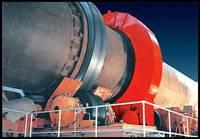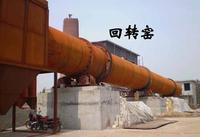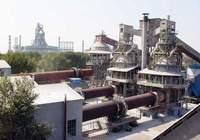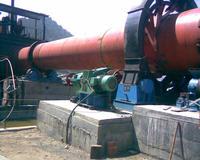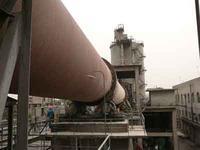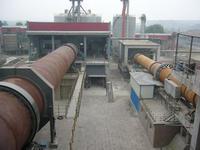The parameters are as follows:
Rotaryrotary
kilnkiln refers to rotary calcining kiln (commonly known as rotary kiln), which belongs to building materials equipment. Rotary kiln can be divided into cement kiln, metallurgical chemical kiln and lime kiln according to different processing materials. Rotary kiln can be divided into cement kiln, metallurgical chemical kiln and lime kiln according to different processing materials. The cement kiln is mainly used for calcining cement clinker, and it is divided into two types: cement kiln and wet kiln. Metallurgical chemical kiln is mainly used for magnetization roasting of iron ore in iron and steel industry in metallurgical industry; oxidizing roasting of chromium and ilmenite; roasting of high alumina bauxite ore and roasting clinker of aluminum plant in refractory plant; aluminum hydroxide in chemical plant; And minerals such as chrome ore. The lime kiln (ie active lime kiln) is used to roast the active lime and light burnt dolomite used in steel plants and ferroalloy plants.
Basic information of rotary kiln
In many production industries such as building materials, metallurgy, chemical industry and environmental protection, the rotary material is widely used for mechanical, physical or chemical treatment of solid materials. Such equipment is called rotary kiln.
back to the brick
The application of the rotary kilnkiln originated from cement production. In 1824, the British cement worker J Asp invented the intermittent operation of the kiln; in 1883, the German Dietz invented the continuous operation of the multi-layer vertical kiln; 1885 British Lan Eransome invented the rotary kiln, which was put into production after patents were obtained in the UK and the US, and quickly gained considerable economic benefits. The invention of rotary kiln has made the cement industry develop rapidly, and it has also promoted the research on the application of rotary kiln. Soon, rotary kiln is widely used in many industrial fields and is becoming more and more important in these productions, becoming the core of corresponding enterprise production. device. Its technical performance and operation determine the quality, output and cost of the company's products to a large extent. “As long as the big kiln turns, there are thousands of dollars.” This folk song is a vivid description of the importance of the rotary kiln in production. In the field of application of rotary kiln, the cement industry has the largest number.
The whole production process of cement is summarized as “two grinding and one burning”, in which “one burning” is the process of burning raw materials prepared by grinding and burning into clinker under the high temperature of rotary kiln. Therefore, the rotary kiln is the main engine in the production of cement, commonly known as the "heart" of the cement factory. In the building materials industry, in addition to calcined cement clinker, rotary kiln is also used for calcining clay, limestone and slag drying. In the production of refractory materials, rotary kiln calcined raw materials are used to make the dimensional stability and strength increase. Processing and forming. In the non-ferrous and ferrous metallurgy, iron, aluminum, copper, zinc, tin, nickel, tungsten, chromium, bismuth and other metals are used as smelting equipment for rotary kiln, and ore, concentrate, intermediates, etc. are sintered and calcined. For example, aluminum is used to roast aluminum hydroxide into alumina; it is used in iron making to produce pellets for blast furnace ironmaking; foreign "SL/RN method" and "Krupp method" use it for iron ore Direct reduction; chlorination volatilization roasting method uses it to extract tin and lead. During the beneficiation process, the lean kiln is used to magnetize the lean iron ore to change the original weak magnetic properties of the ore to strong magnetic properties to facilitate magnetic separation. In the chemical industry, rotary soda is used to produce soda, calcined phosphate fertilizer, and barium sulfide. In the 1960s, LapPle et al. invented a new process for producing phosphoric acid from rotary kiln. The method has the advantages of low energy consumption, low power consumption, no use of sulfuric acid and available medium and low grade phosphate rock, and is quickly popularized.
In the production of rotary kiln, there is often a phenomenon of ring formation. Now most of them use the method of cleaning workers, but they affect production and increase production costs. The rotary kiln cleaning machine that has just been developed avoids this phenomenon. Can handle the ring phenomenon very well.
In addition, in terms of environmental protection, developed countries in the world have used cement kilns to burn hazardous waste and garbage for more than 20 years. This not only reduces waste and harmless waste, but also uses waste as fuel to save coal powder. Recycling of waste.
Types of rotary kiln The
cement industry has developed different production methods and different types of rotary kiln in the development process. According to the raw material preparation method, it can be divided into dry production and wet production. The rotary kiln is compatible with the production method. Dry rotary kiln and wet rotary kiln. Due to the different kiln heat exchange devices in the kiln, they can be divided into different types of kiln.
Classification of
rotaryCement rotary kiln
kilncement kiln currently has two major categories, one is the kiln cylinder lying (slightly inclined), and can be used for rotary motion called rotary kiln (also called rotary kiln); The kiln cylinder is called a vertical kiln.
1. Types of wet rotary kiln:
The cement kiln used in wet production is called wet kiln, and the wet production is to make the raw material into slurry containing 32%~40% water. Since it is prepared into a fluid slurry, the raw materials are well mixed, the raw material components are uniform, and the quality of the fired clinker is high, which is a main advantage of wet production.
2, the type of:
dry rotary kilndry rotary kiln and wet rotary kiln compared to the advantages and disadvantages of the opposite. The dry process produces the raw meal as a dry raw meal with a moisture content generally less than 1%, so it reduces the amount of heat required to evaporate moisture than the wet process. Because of the high temperature of the exhaust gas, the hollow kiln has a low heat consumption. The dry process produces the raw meal into a dry powder, which is less fluid than the mud. Therefore, the raw materials are not well mixed and the ingredients are not uniform.
The cement rotary kiln is
mainly used for calcining cement clinker, and is divided into two categories: cement rotary kiln and wet process cement rotary kiln. Metallurgical chemical rotary kiln is mainly used for magnetization roasting of iron ore in iron and steel industry in metallurgical industry; oxidizing roasting of chromium and ilmenite; roasting of high alumina bauxite ore and roasting clinker of aluminum plant in refractory plant; aluminum hydroxide in chemical plant Minerals such as ore and chrome ore. Lime rotary kiln (ie active lime rotary kiln) is used for roasting active lime and light burnt dolomite for steel and iron alloy plants.
The wet rotary kiln process is
only introduced and analyzed by the wet rotary kiln process. The wet rotary kiln body is usually long (length to diameter ratio is 30 to 40). In order to increase the heat transfer area of the kiln, a chain is often attached at the end of the kiln to accelerate water evaporation. When the wet rotary kiln is produced, water is added to the raw mill to make the raw material into water.
rotary kiln
30% to 40% of the slurry in theis homogenized to the required slurry. The slurry is sent to the kiln for calcination of the mature material. The kiln clinker is cooled by the cooler and sent to the clinker. Drying and grinding into pulverized coal and then burning to supply the calories required for calcination.
The characteristics of the calcination of the wet rotary kiln are: because the raw material is made into mud, the adaptability to the heterogeneous raw material is strong, the raw material composition is uniform, the process is stable, the clinker quality is high, the clinker strength grade is high, and the grinding is high. There is less dust in the process and less fly ash at the kiln. However, in the wet production process, 30% to 40% of the slurry moisture is evaporated, which requires a large amount of heat, and the energy consumption accounts for 1/2 to 1/3 of the cement cost, which is higher than that of the vertical kiln and the dry rotary kiln. Due to high heat consumption, high energy consumption, and large water consumption during production and consumption of water resources, wet production has been classified as a restricted kiln type in China.
The type of cement shaft kiln is characterized
by two types of shaft kiln currently used in China: ordinary shaft kiln and mechanical shaft kiln.
Ordinary shaft kiln is manual feeding and manual unloading or mechanical feeding, manual unloading; mechanical shaft kiln is mechanical feeding and mechanical unloading. The mechanical shaft kiln is continuously operated, and its production, quality and labor productivity are higher than ordinary shaft kiln. According to the requirements of building materials technology policy, small cement plants use mechanized vertical kiln to gradually replace ordinary shaft kiln.
The main structurekiln body includes
of the rotary1. kiln shell, which is the main body of the rotary kiln (rotary kiln). The kiln shell steel plate has a thickness of about 40mm, near the tire ring, because the bearing capacity is relatively large, the kiln shell here The steel plate should be thicker. The interior of the kiln shell is covered with a layer of refractory bricks of about 200 mm. When the kiln shell is in operation, due to the relationship between high temperature and load bearing, the kiln shell will have an elliptical deformation, which will exert pressure on the kiln brick and affect the life of the kiln brick. At the end of the kiln, about one meter long is tapered, so that the material from the preheater feed chamber can enter the kiln more smoothly.
2. The tire ring, support roller, bearing, tire ring and support roller are used to support the weight of the kiln. The tire ring is sleeved on the kiln shell, and it is not fixed between the kiln shell. The kiln shell and the tire ring are separated by an iron plate to keep a certain gap between the tire ring and the kiln shell. too small. If the gap is too small, the expansion of the kiln shell is limited by the tire ring, and the kiln brick is easily damaged. If the gap is too large, the relative movement between the kiln shell and the tire ring, the friction is more harmful, and the elliptical deformation of the kiln shell is more serious. It is usually necessary to add lubricant between the two. Our door can estimate the degree of elliptical deformation of the kiln shell by the relative motion between the kiln shell and the tire ring.
There is a difference in thermal conductivity between the kiln shell and the tire ring. It is necessary to use an external windmill to help the kiln shell to dissipate heat and balance the temperature difference between the two. Otherwise the expansion of the kiln shell will be limited by the tire ring. When the kiln is opened, the heating rate of the kiln shell is higher than that of the tire ring. The kiln must control the heating rate of the rotary kiln (rotary kiln) at 50 °C / h, which is beneficial to protect the kiln brick. Usually, the roller is 50-100 mm larger than the wheel. The roller bearing is made of babbitt. If the bearing loses lubrication, the bearing will burn out due to excessive temperature. There is cooling water at the bearing for circulating cooling. In order to reduce the heat radiation of the kiln shell to the tire ring, the temperature of the roller is too high, and a heat insulation plate is added between the two to reduce heat radiation. Rotary kiln (rotary kiln) generally has 2 to 3 sets of rollers.
3. The thrust roller
thrust roller is the limit switch that limits the rotary kiln (rotary kiln) when it is eaten or eaten. Because the support roller is wider than the kiln tire, in order to make the roller and the belt move up and down, the wear is even. A thrust roller is provided on the end surface of the tire ring.
The thrust roller only acts as a barrier, and the roller itself has no power. The eating and eating of the kiln body depends on the deviation of the roller. The supporting wheel and the center line of the kiln have a certain angle, so that the supporting wheel gives the kiln body an upward force and moves the kiln shell upward. Sometimes the raw material powder is sprinkled or the roller is wiped clean, and the friction coefficient is increased to move the kiln up. When the kiln body is eaten, as long as the graphite powder is sprinkled between the supporting wheel and the wheel belt, the friction between the two can be reduced. When the rotary kiln (rotary kiln) eats and touches the Y1 switch, the hydraulic system starts to take action, the hydraulic system eats for 1 minute, stops for 4 minutes, and then repeats the action of stopping for 1 minute for 4 minutes until the kiln tire ring touches. Go to the Y5 position. At this point, the kiln body began to eat, the hydraulic system was released for 2 minutes, stopped for 4 minutes, and then repeated. Until the kiln touches the Y1 position and eats again. Repeat the above process continuously. When the hydraulic system stops, the internal pressure does not change.
The hydraulic system also has three to limit switches. When eating, if the Y1 switch is faulty, the kiln body will touch the Y second switch, the system will alarm (the kiln body has exceeded the eating range of 30mm), and if it touches the third switch, the system will Jumping (at this point, beyond the 50mm range). When the rotary kiln (rotary kiln) is eaten, if the first switch is faulty, the rotary kiln (rotary kiln) will alarm when it touches the second switch, but it will not jump because there is a thrust roller. Limiting the kiln shell to eat the limit
rotary kiln ignition
YT-16 series rotary kiln wireless temperature measurement system
rotary kiln wireless temperature measurement equipment, using the latest wireless communication technology, the temperature data measured by the thermocouple kiln is transmitted to the operation room display. The kiln temperature transmitter is battery powered and can simultaneously acquire multiple thermocouple signals. It is installed on the kiln body and rotates with the cylinder, due to the heat insulation measures
The rotary kiln
can withstand the high temperature of the cylinder above 300 °C, anti-rain, anti-sun and anti-vibration. The kiln temperature
receiver is installed in the operation room to directly display the temperature in the kiln and has a 4-20 mA output, which can be sent to a computer or other instrument display. The set of equipment is not only simple in structure, convenient in installation, reliable in operation, economical and practical, and the data is accurate and stable, the maintenance is small, and the service life is long.
Technical parameters
Temperature range: 0~2000 °C (segment)
System accuracy: 0.5
Transmitter transmission interval Time: fast hair 10-30 seconds, slow hair 60-180 seconds;
ambient temperature: can withstand radiant high temperature of kiln body above 300 °C,
protection grade: IP65 (rain, sun, vibration);
equipment working mode: 24 hours;
wireless transmission distance: 150 m (500 m forwarding);
signal output form: temperature display (4-20mA current, RS485
interface,Rs232 interfaces optional).
Rotary kiln in China
from the direction of the development of China's cement industry, The sustainable development of the cement industry will go through three stages. In the first stage, the development of large-scale new dry process cement production technology and equipment will be promoted to promote the structural adjustment of the domestic cement industry. China is developing large-scale new dry process cement production technology. Large-scale dry-process cement technology refers to the process and complete sets of equipment for 10000t/d cement clinker production line. The equipment is energy-saving and consumption-reducing, reducing environmental load and harmonious with the environment.
The rotary kiln will reach the world advanced level... The
cement rotary kiln
cement rotary kiln belongs to the building materials equipment category. Rotary kiln can be divided into cement rotary kiln, metallurgical chemical rotary kiln and lime rotary kiln according to different processing materials.
Cement rotary kiln
cement rotary kiln is the main equipment for cement clinker dry and wet production lines. Rotary kiln is widely used in metallurgy, chemical industry, building refractory materials, environmental protection and other industries. The rotary kiln is composed of a cylinder body, a supporting device, a wheel bearing supporting device, a transmission device, an active kiln head, a kiln tail sealing device, a coal injection pipe device and the like. The kiln body of the rotary kiln is inclined to the horizontal level. The whole kiln body is supported by the supporting wheel device, and the retaining wheel device for controlling the kiln body to move up and down. In addition to the main drive, the transmission system is also provided in the main power source. The auxiliary drive device that can rotate the kiln body during breakage to prevent bending deformation of the kiln body, the kiln head and the kiln tail seal device adopt advanced technology to ensure the reliability of the seal.
The rotary kiln of the cement rotary kiln has a solid structure, stable operation and high quality of the kiln product, and can provide users with advanced high-efficiency vertical cylinder preheater and five-stage cyclone preheater.
In addition to calcined cement clinker, the cement rotary kiln is also used for calcining clay, limestone and slag drying. In the production of refractory materials, the rotary kiln is used to calcine the raw materials to make the dimensional stability, strength increase and re-formation. In the non-ferrous and black metallurgy, iron, aluminum, copper, zinc, tin, nickel, tungsten, chromium, antimony and other metals are used as smelting equipment for rotary kiln, and ore, concentrate, intermediates, etc. are sintered and calcined. For example, aluminum is used to roast aluminum hydroxide into alumina; it is used in iron making to produce pellets for blast furnace ironmaking; foreign "SL/RN method" and "Krupp method" use it for iron ore Direct reduction; chlorination volatilization roasting method uses it to extract tin and lead. During the beneficiation process, the lean kiln is used to magnetize the lean iron ore to change the original weak magnetic properties of the ore to strong magnetic properties to facilitate magnetic separation. In the chemical industry, rotary soda is used to produce soda, calcined phosphate fertilizer, and barium sulfide. The method has the advantages of low energy consumption, low power consumption, no use of sulfuric acid and available medium and low grade phosphate rock, and is quickly popularized.
In addition to environmental protection, cement kiln is used to incinerate hazardous waste and garbage. This not only reduces waste and harmless waste, but also uses waste as fuel to save coal powder and recycle waste.
Technical Parameters
classification
according to the different heating methods, divided into two categories of internal heating and external heating.
The material of the internal heating rotary kiln is in direct contact with the flame and the flue gas, and the oxidizing or reducing atmosphere in the furnace can be realized by adjusting, and the refractory brick is built on the inner wall of the cylinder, and the head and tail lining is lining for high-strength wear-resistant castable, head and tail cover and cylinder The body is a flexible seal that completely eliminates dust and material leakage. Multiple gears can be used to achieve a cylinder length of 60 meters and a maximum temperature of 1600 °C. The output is large, and the applicable fuels are liquefied gas, natural gas, coal gas, fuel oil, coal powder, coal, and the like.
The material of the externally heated rotary kiln is not in direct contact with the flame and the flue gas. The heat source is between the heating furnace and the cylinder, and the material is heated by the heat transfer of the heat-resistant steel cylinder wall. The lining of the heating furnace is refractory fiber, which can save energy and reduce consumption. Limited by the heating method and the material of the cylinder, the length of the cylinder is ≤15 meters and the heating temperature is ≤1200 °C. The output is small, and the heating method is: electric heating, gas, fuel oil, coal burning, and the like.
Metallurgical rotary kiln
metallurgical rotary kiln: metallurgical chemical kiln is mainly used in metallurgical industry steel plant iron ore magnetization roasting; chromium, ferronic oxide oxidization roasting; refractory plant roasting high metallurgical mine and aluminum plant roasting clinker, aluminum hydroxide; The chemical plant roasts minerals such as chrome ore and chrome ore.
kiln
Metallurgical rotarymetallurgical rotary kiln main parameter table
machine installation and maintenance:
Machine maintenance is an extremely important and regular work. It should be closely coordinated with extreme operations and maintenance. There should be full-time personnel on duty.
I. Maintenance of the machine:
1. The shaft of the bearing
crusher bears the full load of the negative machine, so good lubrication has a great relationship with the bearing life. It directly affects the service life and operation rate of the machine, thus requiring the injected lubricant. Must be clean, the seal must be good, the main oil filling part of the machine (1) rotating bearing (2) roll bearing (3) all gears (4) movable bearing, sliding plane.
2. The newly installed tires are prone to loosening and must be inspected frequently.
3. Pay attention to whether the work of all parts of the machine is normal.
4, pay attention to check the wear level of wearable parts, always pay attention to replace the worn parts.
5. The plane of the undercarriage of the movable device should be out of dust and other materials to prevent the movable bearing from moving on the chassis when the machine encounters unbreakable materials, resulting in serious accidents.
6, the bearing oil temperature rises, should stop immediately to check the reasons to eliminate.
7. If there is impact sound during the operation of the rotating gear, stop it immediately and eliminate it
. 2. Install the test drive
1. The equipment should be installed on the horizontal concrete foundation and fixed with anchor bolts.
2. When installing, pay attention to the vertical direction of the main body and the horizontal.
3. After installation, check whether the bolts in all parts are loose and the main door is tight. If necessary, tighten them.
4. Configure the power cord and control switch according to the power of the device.
5. After the inspection is completed, the empty load test is carried out, and the test can be carried out normally.
Lime rotary kiln: commonly known as drum rotary kiln
Lime Kiln
Lime Rotary Kiln Technical Features:
Lime rotary kiln
● The lime rotary kiln has advanced structure. The vertical preheater with low pressure loss can effectively improve the preheating effect. The precalcined limestone can be decomposed into the kiln by 20-25%, and can be directly used for 10-15mm. Granular limestone;
● Lime rotary kiln reliable rotary kiln with fixed scale seals at both ends. Make the air leakage coefficient less than 10% use composite refractory material to reduce radiant heat loss;
● Lime rotary kiln filled, partitionable ventilated circular or square vertical cooler, so that the cooler's lime temperature is 800C + ambient temperature, Easy to transport, store, and preheat the secondary air into the kiln to more than 7000C, reducing moving parts and special materials.
Main parameters of active lime production rotary kiln series
Design of the lime rotary kiln The design of the
rotary kiln shall comply with the following requirements:
1 The specifications of the rotary kiln shall be based on the requirements for the production of the firing system, combined with the original, fuel conditions and preheater, decomposition furnace, and chiller. Factors such as the configuration situation are comprehensively determined.
2 The length to diameter ratio (L/D) of the preheater kiln and the precalciner kiln should be 11-16.
3 The preheater kiln and the precalciner kiln should have a slope of 3.5%-4%; the maximum speed: the precalciner should be 3.0-3.5r/min, and the preheater kiln should be 2.0-2.5r/min; Range 1: 10 .
4 The cooling of the rotary kiln firing cylinder should be forced air cooling.
5 Rotary kiln firing zone should have detection measures for cylinder temperature.
6 The main motor of the rotary kiln should adopt a stepless variable speed motor and an auxiliary drive should be set. The auxiliary drive should have backup power.
The layout of the rotary kiln should meet the following requirements:
1 The height of the rotary kiln should be determined according to the type and arrangement of the clinker cooler.
2 Rotary kiln foundation piers should meet the following requirements:
1) The installation dimensions of the rotary kiln should be based on the cold kiln;
2) The horizontal distance between the foundation piers should be determined according to the size after thermal expansion;
3) Kiln shaft For the calculation of thermal expansion, the center of the belt with the retaining wheel near the transmission should be used as the reference point to expand to both ends;
4) The slope of the foundation surface should be equal to the slope of the kiln cylinder, and the foundation hole should be perpendicular to the base surface. .
3 When there are more than two rotary kiln, the determination of the center distance between the two kiln should meet the following principles:
1) meet the layout requirements of the kiln head and kiln equipment;
2) facilitate the operation and maintenance of the equipment;
3) combine with the central control room Reasonable location.
Metal magnesium rotary kiln
metal magnesium equipment production line Features
Annual production of 5,000 tons of metal magnesium equipment configuration E broken machine, fine crusher, 2.5X40 rotary kiln, 2X20 m cooler, MQG1.83X7 rice ball mill, MQG1.5X5.7 ball mill, MG1725 coal Mill, HL300 bucket elevator, gas generator 2.5 meters, ball press, vertical preheater, GX400 screw conveyor Our factory specializes in the production of metal magnesium complete sets of equipment and processes, the process raw materials (dolomite) is broken by the crusher Qualified material (30-40mm), cooled by rotary kiln and cooled by a cooling machine. After being ground into a ball by a ball mill, the ball is pressed into a ball by a ball press. The dolomite is calcined into a calcined white in a rotary kiln or a shaft kiln. The ferrosilicon powder and the fluorite powder are uniformly mixed into a mass, placed in a heat-resistant stainless steel reduction tank, placed in a reduction furnace, and reduced to obtain coarse magnesium at a vacuum of 1.23 Pa at a vacuum of 1.33 Pa, and refined and cast by a flux. Ingots and surface treatments give finished magnesium ingots. Disadvantages of Pijiang Process Magnesium Smelting: 12 tons of dolomite are consumed in the production of 1 ton of metal magnesium ingot; 8-10 tons of anthracite and bituminous coal; 5-6 tons of by-product reducing slag. These reducing slags have not yet found better. Use, pollute the environment; labor intensity, dust pollution in raw material workshop is serious. The nickel content is too low. If it is to be recycled by flotation, the impurity magnesium may be difficult to control.
Annual production of 5,000 tons of metal magnesium equipment configuration
400X600 E broken machine, 250X1000 crusher, 2.5X40 rotary kiln, 2X20 m cooler, MQG1.83X7 rice ball mill, MQG1.5X5.7 ball mill, MG1725 coal mill, HL300 bucket elevator , gas generator 2.5 meters, ball press, vertical preheater, GX400 screw conveyor annual output of 10,000 tons (10,000 tons) of metal magnesium equipment configuration
600X900 E broken machine, 250X1200 fine jaw crusher, 3X60 rotary kiln, 2.2X20 meter cooler, MQG2.4X8 rice ball mill, MQG1.5X5.7 ball mill, MG2233 coal mill, HL300 bucket elevator, gas generator 3 meters, ball press, vertical preheater, GX400 screw conveyor Annual production of 30,000 tons of metal magnesium equipment configuration
ceramsite sand rotary kiln
ceramic rotary kiln working principle
kiln rotary kiln heat rotary kiln medium temperature (950 °C ~ 1050 °C) calcined ultra-fine kaolin technology, mature, domestic advanced, representing The development direction of ultra-fine kaolin calcination technology. This calcination technology has low energy consumption and high output. The product is dehydrated, decarburized and whitened, and has stable performance. It can be used in industrial fields such as papermaking and coatings.
Ceramsite rotary kiln product features
ceramsite rotary kiln is widely used in dolomite, kaolin, bauxite, refractory charge, cement, limestone, ferrotitanium, antimony ore, activated carbon, coke, mineral powder, alumina, magnesia, Zinc oxide, special cement and other industries.
ceramsite rotary kiln
Technical specifications ofProduct specifications
(m) Production capacity
(t/d) Main motor main reducer weight
(t)
Model power (kw)
Model speed ratio
φ 18x26 72 JZT2-72-4 30 JZQ750-1- I 48.57 66
φ 1.9/1.6x39 72 JZT2-72-4 30 JZQ750-1- I 48.57 66
φ 1.9x36 84 YCT315-4A 37 ZS110-5- III 78.19 85.9
φ 2.2x45 98.4 JZT82-6 55 ZA125 93.93 104
φ 2.5x40 160 Z2--92 40 ZS125-2- I 134.9 143
φ 2.5x45 170 JTZ82-4 45 ZS125-4- I 69.71 148
φ 2.5x50 180 ZT3-72-4 30 ZS145-9- V 122.8 173
φ 2.5x60 168 YCT355- 4B 75 ZS165-7- II 99.96 222







